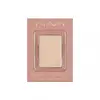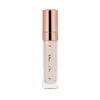What's inside
What's inside
 Key Ingredients
Key Ingredients

 Benefits
Benefits

 Concerns
Concerns

 Ingredients Side-by-side
Ingredients Side-by-side

Petrolatum
EmollientIsocetyl Stearoyl Stearate
EmollientBis-Diglyceryl Polyacyladipate-2
EmollientPolyglyceryl-3 Diisostearate
EmulsifyingTribehenin
EmollientTapioca Starch
Silica Silylate
EmollientPolymethylsilsesquioxane
Cera Microcristallina
Emulsion StabilisingParaffin
PerfumingOctyldodecanol
EmollientStearic Acid
CleansingMagnesium Hydroxide
AbsorbentCaprylyl Glycol
EmollientPhenoxyethanol
PreservativeAluminum Hydroxide
EmollientPEG-8
HumectantSorbitan Oleate
EmulsifyingHexylene Glycol
EmulsifyingTocopherol
AntioxidantAscorbyl Palmitate
AntioxidantAscorbic Acid
AntioxidantCitric Acid
BufferingCI 77891
Cosmetic ColorantCI 19140
Cosmetic ColorantCI 77499
Cosmetic ColorantCI 77491
Cosmetic ColorantCI 77492
Cosmetic ColorantPetrolatum, Isocetyl Stearoyl Stearate, Bis-Diglyceryl Polyacyladipate-2, Polyglyceryl-3 Diisostearate, Tribehenin, Tapioca Starch, Silica Silylate, Polymethylsilsesquioxane, Cera Microcristallina, Paraffin, Octyldodecanol, Stearic Acid, Magnesium Hydroxide, Caprylyl Glycol, Phenoxyethanol, Aluminum Hydroxide, PEG-8, Sorbitan Oleate, Hexylene Glycol, Tocopherol, Ascorbyl Palmitate, Ascorbic Acid, Citric Acid, CI 77891, CI 19140, CI 77499, CI 77491, CI 77492
Water
Skin ConditioningCyclopentasiloxane
EmollientIsododecane
EmollientTalc
AbrasivePropylene Glycol
HumectantAluminum Starch Octenylsuccinate
AbsorbentCyclohexasiloxane
EmollientHexyl Laurate
EmollientCetyl PEG/PPG-10/1 Dimethicone
EmulsifyingMagnesium Stearate
Cosmetic ColorantDisteardimonium Hectorite
StabilisingSodium Chloride
MaskingLauryl PEG/PPG-18/18 Methicone
Skin ConditioningPolyglyceryl-4 Isostearate
EmulsifyingPhenoxyethanol
PreservativePropylene Carbonate
SolventGlycerin
HumectantAluminum Hydroxide
EmollientDimethicone/Vinyl Dimethicone Crosspolymer
Skin ConditioningParfum
MaskingHdi/Trimethylol Hexyllactone Crosspolymer
Ethylhexylglycerin
Skin ConditioningRosa Hybrid Flower Extract
Skin ConditioningSilica
AbrasiveCaprylyl Glycol
EmollientSodium Benzoate
MaskingPotassium Sorbate
PreservativePentaerythrityl Tetra-Di-T-Butyl Hydroxyhydrocinnamate
AntioxidantAcetyl Hexapeptide-8
HumectantLinalool
PerfumingBenzyl Salicylate
PerfumingAlpha-Isomethyl Ionone
PerfumingLimonene
PerfumingCoumarin
PerfumingCI 77891
Cosmetic ColorantCI 77163
Cosmetic ColorantCI 77492
Cosmetic ColorantCI 77491
Cosmetic ColorantCI 77499
Cosmetic ColorantWater, Cyclopentasiloxane, Isododecane, Talc, Propylene Glycol, Aluminum Starch Octenylsuccinate, Cyclohexasiloxane, Hexyl Laurate, Cetyl PEG/PPG-10/1 Dimethicone, Magnesium Stearate, Disteardimonium Hectorite, Sodium Chloride, Lauryl PEG/PPG-18/18 Methicone, Polyglyceryl-4 Isostearate, Phenoxyethanol, Propylene Carbonate, Glycerin, Aluminum Hydroxide, Dimethicone/Vinyl Dimethicone Crosspolymer, Parfum, Hdi/Trimethylol Hexyllactone Crosspolymer, Ethylhexylglycerin, Rosa Hybrid Flower Extract, Silica, Caprylyl Glycol, Sodium Benzoate, Potassium Sorbate, Pentaerythrityl Tetra-Di-T-Butyl Hydroxyhydrocinnamate, Acetyl Hexapeptide-8, Linalool, Benzyl Salicylate, Alpha-Isomethyl Ionone, Limonene, Coumarin, CI 77891, CI 77163, CI 77492, CI 77491, CI 77499
Ingredients Explained
These ingredients are found in both products.
Ingredients higher up in an ingredient list are typically present in a larger amount.
Aluminum Hydroxide is a form of aluminum. It can be naturally found in nature as the mineral gibbsite. In cosmetics, Aluminum Hydroxide is used as a colorant, pH adjuster, and absorbent.
As a colorant, Aluminum Hydroxide may add opacity, or reduce the transparency. Aluminum hydroxide is contains both basic and acidic properties.
According to manufacturers, this ingredient is an emollient and humectant. This means it helps hydrate the skin.
In medicine, this ingredient is used to help relieve heartburn and help heal ulcers.
There is currently no credible scientific evidence linking aluminum hydroxide in cosmetics to increased cancer risk.
Major health organizations allow the use of aluminum hydroxide in personal care products and have not flagged it as a carcinogenic risk at typical usage levels.
Learn more about Aluminum HydroxideCaprylyl Glycol is a humectant and emollient, meaning it attracts and preserves moisture.
It is a common ingredient in many products, especially those designed to hydrate skin. The primary benefits are retaining moisture, skin softening, and promoting a healthy skin barrier.
Though Caprylyl Glycol is an alcohol derived from fatty acids, it is not the kind that can dry out skin.
This ingredient is also used as a preservative to extend the life of products. It has slight antimicrobial properties.
Learn more about Caprylyl GlycolCi 77491 is also hydrated iron III oxide. It's sole purpose is to give a red/pink hue to products.
Iron III oxides are classified as inorganic chemicals for coloring.
Synthetically created Ci 77491 is considered safer than those naturally found. This is because the synthetically created version may contain less impurities. Iron oxides are generally non-toxic and non-allergenic.
Learn more about CI 77491Ci 77492 is also hydrated iron III oxide. It's sole purpose is to give a yellow hue to products.
Iron III oxides are classified as inorganic chemicals for coloring.
Synthetically created Ci 77492 is considered safer than those naturally found. This is because the synthetically created version may contain less impurities. Iron oxides are generally non-toxic and non-allergenic.
Learn more about CI 77492Ci 77499 is also hydrated iron III oxide. It is created from mixing red and black iron oxides. This helps give shades of darkness to a product.
Iron III oxides are classified as inorganic chemicals for coloring.
Ci 77891 is a white pigment from Titanium dioxide. It is naturally found in minerals such as rutile and ilmenite.
It's main function is to add a white color to cosmetics. It can also be mixed with other colors to create different shades.
Ci 77891 is commonly found in sunscreens due to its ability to block UV rays.
Learn more about CI 77891Phenoxyethanol is a preservative that has germicide, antimicrobial, and aromatic properties. Studies show that phenoxyethanol can prevent microbial growth. By itself, it has a scent that is similar to that of a rose.
It's often used in formulations along with Caprylyl Glycol to preserve the shelf life of products.